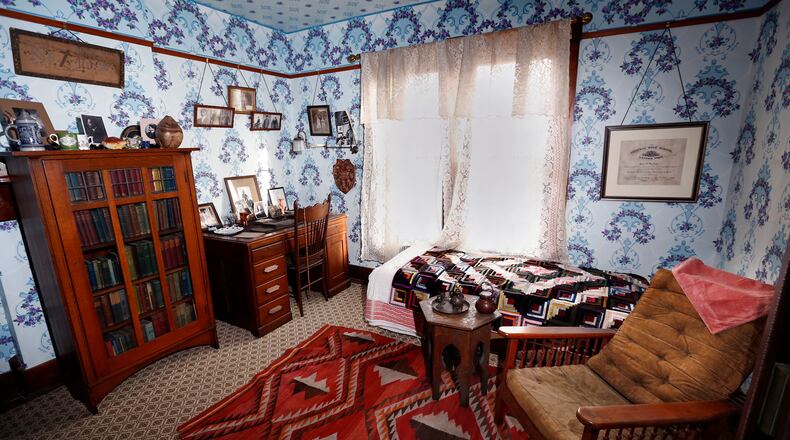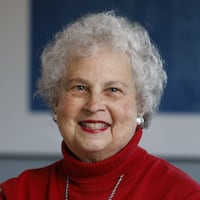Dunbar, who was born in Dayton to parents who had been enslaved, lived from 1872 to 1906. Thanks to his devoted and supportive mother, Matilda, he started writing stories and verse as a child and achieved fame as one of the first nationally known African-American writers.
With his sesquicentennial anniversary being celebrated this year, it’s the perfect time to visit the home where Dunbar lived with his mother in the final years of his life. Officially owned by the Ohio History Connection (formerly the Ohio Historical Society), the tours and operations are conducted by National Park Service rangers.
Walking through the house is like stepping back in time. In 1903, suffering from tuberculosis, Dunbar purchased the two-story brick for his mother. She cared for him there in his final years until his death at age 33.
Matilda continued to live in the home, opening it as a museum, until her own death in 1934. In 1936, the Ohio Historical Society acquired the house and the responsibility of running the museum. A project completed in 2003 has returned the house as much as possible to the time when Dunbar and his mother lived there.
Credit: Russell Florence
Credit: Russell Florence
Laura and I were fortunate to take the Dunbar tour with LaVerne Sci, a Dayton treasure who worked at the home for 20 years before her retirement as site manager and director. She still volunteers at the House and also presides over an annual graveside tribute to Dunbar at Woodland Cemetery on the day of his death, Feb. 9.
What’s so wonderful about Sci is that she’s likely to burst into animated recitations of Dunbar poems whenever and wherever she talks about her favorite poet. She says she inherited the love of Dunbar’s poetry from a mother and grandfather who recited it frequently.
Here, in Sci’s words, are a few of her favorite spots in the Dunbar House:
- “I’m fond of the dining room because it functioned in so many capacities. Over time that room has quietly witnessed love, concern and change. In addition to taking in washing, Mother Dunbar sewed for people to expand her income and she used it as a place for people to be fitted. It became a work area for her. When I stand in that room today and look around, I see the rocking cradle that Mother Dunbar brought from Kentucky and rocked her babies in.”
- “The first room as you go up the steps is the loafing-holt, with Paul’s desk, his daybed and books. That’s where he would sit in a comfortable chair and read.”
- “There is a piece of furniture that lets down into a bed. At one time, after her son’s death, many prominent people who came through Dayton would go by the house. There weren’t a lot of hotels accepting Black people and they would sleep one or two nights on that bed.”
Other treasures on display in the turn-of-the-century house include Dunbar’s bicycle given to him by the Wright brothers; his collection of Native American art and a ceremonial sword that President Theodore Roosevelt presented to him.
“He endured and he struggled and it was through his determination that he found what really did sparkle in his life and that was writing,” says Sci.
As I’d expected, cousin Laura loved the Dunbar House.
“I remember it as being such an intimate experience,” she says now. “It was very direct and you really felt like you had visited a person’s house and gotten to know the individual. I really liked the fact you could stand there and use your imagination and just experience the house. I prefer wandering through something authentic that hasn’t been tampered with as opposed to pushing little buttons everywhere.”
Advice on touring
Park ranger Angela Stewart is serving as the project manager for the 150th anniversary and also gives tours of the Dunbar House.
She recommends that visitors allow about an hour and 15 minutes to tour the house. There’s a self-guided tour of the exhibit space and a guided tour of the home. It’s advisable to begin with the 18-minute film that provides information on Dunbar’s life.
“The tour is always different,” says Stewart. “We want to make the tour relevant to visitors and to let them know how Dunbar’s life relates to ours. We talk about the fact that he was not only a poet but a writer as well. He wrote a total of 12 books including novels, poetry collections and short stories.”
Children, she notes, are always interested in the objects that are different from the things in their own homes. “There’s a telephone in the house that looks completely different from the phones in their homes today. There was a lot of crazy quilting done during that time and the kids are interested in the quilts.”
A new exhibit
A current exhibit at the house — “Paul Laurence Dunbar: Diamond of the Gem City” — focuses on the poet’s life within a community of African-American activists. The show is co-sponsored by the Ohio History Connection, the National Afro-American Museum and Cultural Center and the National Park Service.
Co-curating the new exhibit are Hadley Drodge and Derek Pridemore of the Afro-American Museum.
Drodge says there are two main goals for the display. “The first was to celebrate the 150th anniversary and create an exhibit that could travel to schools and libraries all over the country that were named for Dunbar. The other was to help reconceptualize Dunbar within the world in which he lived.”
Dunbar’s story, she says, is frequently told in relation to his white audience with an emphasis on the white people who helped him in his career. “We wanted to take another look at that so we went into the archives and read everything in the 20 boxes at the Ohio History Collection. We wanted to see who was important to him in his letters.”
Pridemore says the letters are very important because they reveal Dunbar’s thoughts and feelings about people in his life. Books are important because of the inscriptions from many of the Black activists of the times.
“We went into the collections warehouse and pulled things that had not been seen by the public or not been seen in a very long time,” he explains. “We have his workman’s pass to the Chicago World’s Fair on display.”
He says both journalist Ida B. Wells and Dunbar worked with Black social reformer and orator Frederick Douglass at the fair in 1893 and helped to distribute a pamphlet written by Wells that lauded the achievements of African-Americans and was consequently a form of protest. Dunbar delivered a patriotic poem about veterans at the fair.
Among the items on display are one of Dunbar’s suits. “He loved to dress in fine clothing,” says Pridemore. “We also have an item of clothing that was his mother’s.” Also on display is a photograph from the first all-Black Broadway musical for which Dunbar wrote the lyrics. The show toured America and Europe after running in New York.
“We hope that people from Dayton, all over the state and all over the country can come, immerse themselves in these stories about Dunbar’s life and learn more about ourselves , our past and our present,” says Drodge.
HOW TO GO
What: Paul Laurence Dunbar House
Where: 219 N. Paul Laurence Dunbar St., Dayton
Museum hours: 10 a.m. to 4 p.m. Fridays through Sundays.
Tours: Tours are available when you visit the house and you can also book a tour on a day when the museum is not officially open. Call (937) 225-7705 or email angela_j_stewart@nps.gov. Through special arrangements, it is possible to request a tour by Dunbar scholar LaVerne Sci .
Admission: Free
Parking: Available on the street.
Related programming:
- The sesquicentennial traveling exhibit “Paul Laurence Dunbar: Diamond of the Gem City” will be open at the Dunbar House through Jan. 9, 2023. It will then travel to libraries and other locations.
- A short film and display on Dunbar can also be found at the Wright-Dunbar Interpretive Center, 16 S. Williams St., Dayton.
- On the second Sunday of each month, the Dunbar House hosts a literary circle. In addition to Dunbar’s work, various types of poetry and literature are also shared. The next events will be held from 2-4 p.m. on July 10 and Aug. 14.
About the Author







